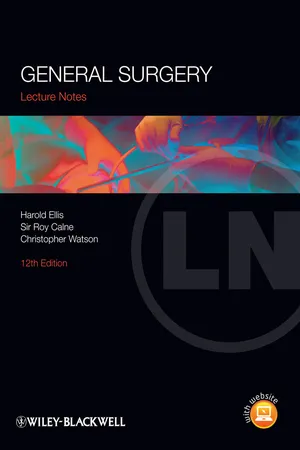
- English
- ePUB (mobile friendly)
- Available on iOS & Android
General Surgery
About This Book
The 12 th edition of General Surgery Lecture Notes introduces the student to the principles of common surgical operations and systematically covers all clinical problems where surgical intervention is indicated.
Now in full colour throughout and fully-supported by a website of self-assessment questions and answers, this popular and classic text will appeal to all medical students and junior doctors who want a concise introduction to the fundamental aspects of general surgery and will provide the core knowledge needed for Finals and the MRCS examination.
Key features include:
- Offers a comprehensive overview of surgical techniques
- Contains a wide range of colour illustrations
- Fully supported by hundreds of self-assessment questions and answers at www.testgeneralsurgery.com
Whether you need to develop or refresh your knowledge of surgery, General Surgery Lecture Notes presents 'need to know' information for all those carrying out general surgical procedures.
Frequently asked questions
Information


| Pain | Rectal bleeding |
| Exact site | Estimation of amount (often inaccurate) |
| Radiation | Timing of bleeding |
| Length of history | Colour – bright red, dark red, black |
| Periodicity | Accompanying symptoms – pain, vomiting (haematemesis) |
| Nature – constant/colicky | Associated shock – faintness, etc. |
| Severity | Blood mixed in stool, lying on surface, on paper, in toilet pan |
| Relieving and aggravating factors | |
| Accompanying features (e.g. jaundice, vomiting, haematuria) |

Table of contents
- Cover
- Series page
- Title page
- Copyright
- Introduction
- Acknowledgements
- Abbreviations
- 1: Surgical strategy
- 2: Fluid and electrolyte management
- 3: Preoperative assessment
- 4: Postoperative complications
- 5: Acute infections
- 6: Shock
- 7: Tumours
- 8: Burns
- 9: The skin and its adnexae
- 10: The chest and lungs
- 11: The heart and thoracic aorta
- 12: Arterial disease
- 13: Venous disorders of the lower limb
- 14: The brain and meninges
- 15: Head injury
- 16: The spine
- 17: Peripheral nerve injuries
- 18: The oral cavity
- 19: The salivary glands
- 20: The oesophagus
- 21: The stomach and duodenum
- 22: Mechanical intestinal obstruction
- 23: The small intestine
- 24: Acute appendicitis
- 25: The colon
- 26: The rectum and anal canal
- 27: Peritonitis
- 28: Paralytic ileus
- 29: Hernia
- 30: The liver
- 31: The gallbladder and bile ducts
- 32: The pancreas
- 33: The spleen
- 34: The lymph nodes and lymphatics
- 35: The breast
- 36: The neck
- 37: The thyroid
- 38: The parathyroids
- 39: The thymus
- 40: The suprarenal glands
- 41: The kidney and ureter
- 42: The bladder
- 43: The prostate
- 44: The male urethra
- 45: The penis
- 46: The testis and scrotum
- 47: Transplantation surgery
- Index